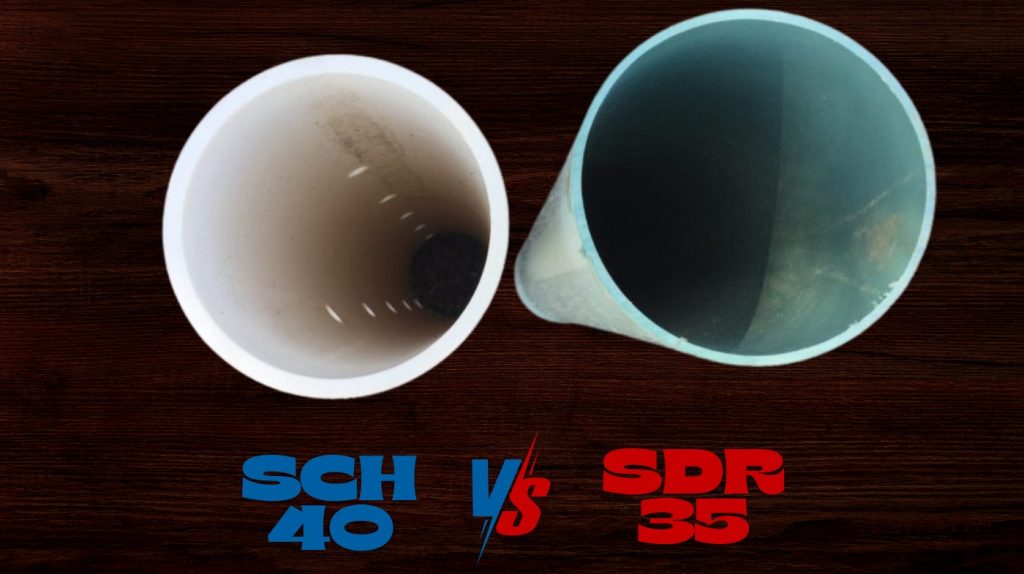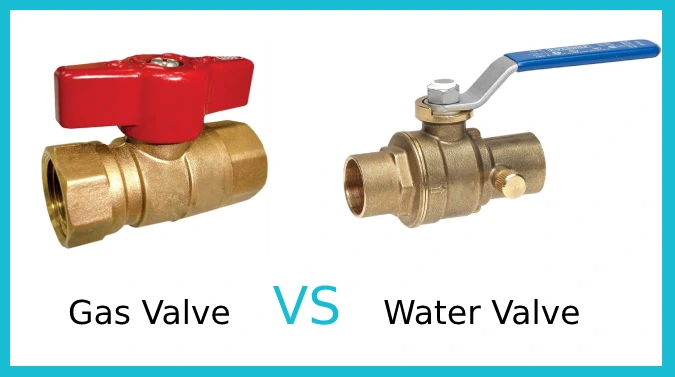Last Updated on August 21, 2025
If you need strong, pressure-rated piping, Schedule 40 with its thicker walls and 4.5-inch OD outperforms SDR 35, which has thinner walls and a smaller 4.215-inch OD meant for low-pressure drainage.
Schedule 40 suits hot water or pressurized systems with robust fittings, while SDR 35 is lighter and impact-resistant for underground use but less durable under high loads.
Understanding these differences helps you pick the ideal pipe for durability, pressure, and installation needs in your project.
- VENTRAL PVC: Pipe and Pressure Fittings are used in irrigation, underground sprinkler systems, swim…
- MADE IN THE USA: For over a century, Ventral has been fabricating pipe and fittings, employing more…
- EASY INSTALLATION: White fittings that are used in potable water applications only; They are…
- MADE IN THE USA: For over a century, Ventral has been fabricating pipe lumber and fittings,…
- VENTRAL Products are Manufactured and/or Designed and Fabricated in the USA
- VENTRAL PIPE AND FITTINGS: Are used in irrigation, underground sprinkler systems, drainage, swim…
Key Takeaways
- Schedule 40 pipes have thicker walls, higher pressure ratings (~100 psi), and are suited for pressurized, high-temperature applications.
- SDR 35 pipes have thinner walls, lower pressure capacity, and are mainly used for sewer, storm drainage, and underground installations.
- Schedule 40’s larger outside diameter (4.5″) differs from SDR 35 (4.215″), making fittings generally non-interchangeable without adapters.
- Both pipe types resist chemicals and corrosion, but Schedule 40 offers greater impact and deformation resistance.
- Schedule 40 pipes are heavier and more widely available, while SDR 35 pipes are lighter and easier to handle but may cost more.
Head-to-Head Comparison between SCH 40 & SDR 35
| Feature | Schedule 40 PVC | SDR 35 PVC |
|---|---|---|
| Wall Thickness | Thicker walls for durability | Thinner walls for cost savings |
| Outside Diameter (4″ pipe) | 4.5 inches | 4.215 inches |
| Pressure Rating | Up to 280 psi (high pressure) | Low pressure applications only |
| Primary Use | Pressurized water systems, plumbing | Drainage, sewer, storm water |
| Temperature Tolerance | Handles hot water applications | Limited to ambient temperatures |
| Installation Weight | Heavier (10.79 lbs/ft for 4″) | Lighter and easier to handle |
| Fitting Compatibility | Standard Schedule 40 fittings | Requires SDR 35 specific fittings |
| Strength | Superior burst resistance | High impact strength underground |
| Best Applications | Low-pressure applications only | Underground drainage, sewer systems |
| Indoor plumbing, irrigation, and industrial | Typically white | Often green for identification |
Key Differences in Material Composition and Dimensions
Although both Schedule 40 and SDR 35 pipes serve similar functions, Schedule 40 pipes primarily use mild steel with low carbon content (0.2%-0.25%), which grants them superior weldability and consistent mechanical properties.
Schedule 40 pipes use low-carbon mild steel, offering enhanced weldability and reliable mechanical performance.
You’ll find Schedule 40 steel produced via electric furnace, open hearth, or basic oxygen processes, focusing on soft, weldable quality. Its dimensional standards adhere to ASME B36.10, where nominal pipe size defines outside diameter; for example, a NPS 14 Schedule 40 pipe measures 14 inches OD.
This standardization ensures dimensional uniformity, critical for reliable installation and system integrity. Wall thickness varies by size—0.068 inches for 1/8-inch nominal, up to 0.237 inches for 4-inch nominal—directly influencing weight per foot.
This thickness corresponds to a weight of approximately 10.79 lbs per foot for a typical 4-inch Schedule 40 pipe. Zinc galvanization enhances corrosion resistance, with coatings averaging 1.8 oz/ft². This ensures dimensional uniformity and compatibility with fittings, supporting a wide range of industrial and fencing applications.
Strength, Pressure Ratings, and Suitable Applications
When selecting between Schedule 40 and SDR 35 pipes, understanding their strength and pressure ratings is critical for ensuring you choose a pipe that meets your system’s demands.
Schedule 40 pipes feature thicker walls and higher strength, supporting pressures around 100 psi, making them ideal for pressurized water systems and industrial fluid transport.
Additionally, Schedule 40 pipes are capable of handling high temperatures, making them suitable for hot water applications. Their robust construction also contributes to longer service life under demanding conditions.
In contrast, SDR 35 pipes have thinner walls and lower pressure ratings, suitable mainly for non-pressurized sewer and storm drainage applications. While SDR 35 offers high impact strength for underground use, it lacks the burst resistance and load-bearing capacity of Schedule 40.
Consequently, you’ll opt for Schedule 40 in residential plumbing or irrigation systems needing robustness, whereas SDR 35 suits light commercial drainage where pressure resistance is less critical.
Chemical Resistance and Environmental Durability
Since both Schedule 40 and SDR 35 pipes are manufactured from polyvinyl chloride (PVC), they inherently resist most chemicals encountered in residential, industrial, and underground applications.
You’ll find both pipe types resist acids, bases, salts, and microbial degradation, ensuring longevity in potable water, wastewater, and irrigation systems. Both Schedule 40 and SDR 35 PVC pipes resist acids, bases, salts, and microbial degradation for lasting use.
However, environmental durability varies:
- SCH 40’s thicker walls offer superior resistance to impact, cracking, and deformation under physical stress, suitable for harsher conditions. Proper fastening of pipe supports is essential to prevent issues related to loose pipe mounting.
- SDR 35 typically avoids UV exposure due to underground use but has thinner walls, requiring proper bedding to prevent damage from heavy loads.
- Both pipes withstand corrosion, rust, and temperature extremes up to 140°F (60°C), but SCH 40 may need UV protection if exposed outdoors for long periods.
- Proper installation quality, including correct alignment and joint sealing with approved solvent cement, is essential to prevent premature failure and extend pipe lifespan. installation quality
Compatibility and Interchangeability of Fittings
Understanding the compatibility and interchangeability of fittings between Schedule 40 and SDR 35 pipes is crucial to guarantee system integrity and performance.
You’ll find that SDR 35 pipes have a smaller outside diameter (4.215 inches for 4″ size) compared to Schedule 40’s 4.5 inches, causing loose fits if you try to use Schedule 40 fittings directly with SDR 35 pipes. Proper selection of fittings and materials ensures chemical compatibility and prevents premature system failure.
Schedule 40 fittings are designed for thicker walls and higher pressure ratings, so mixing them with SDR 35 pipes, which have thinner walls and lower pressure ratings, risks leaks or failures.
To facilitate proper fit and mechanical compatibility, you should use transition couplings, bushings, or fittings conforming to matching ASTM standards.
Always verify supplier documentation to avoid misfits and maintain system reliability. Additionally, PVC Schedule 40 fittings comply with ASTM standards ensuring dimensional accuracy and chemical resistance for reliable connections.
Cost Implications and Installation Considerations
Compatibility between Schedule 40 and SDR 35 pipes directly influences installation choices and overall project costs. When deciding between them, consider these factors:
- Material and Labor Costs: SCH 40 is generally cheaper and widely stocked, but its heavier weight increases labor effort. SDR 35 costs more upfront but eases handling and speeds installation due to lighter weight and flexibility. Additionally, the different pipe constructions affect their performance, with SCH 40 being thicker and more robust compared to the lighter SDR 35. Selecting the correct pipe also requires knowing the appropriate circuit breaker size to ensure system safety when pumps are involved.
- Pressure Ratings and Application: SCH 40’s higher pressure capacity suits pressurized systems, though it may require robust fittings and more complex installation. SDR 35 fits lower-pressure drainage but demands careful handling to avoid damage.
- Availability and Scheduling: SCH 40’s broad availability reduces lead times and shipping expenses. SDR 35’s limited supply might delay projects and increase transportation costs, affecting your budget and timeline. It is important to note that pressure-rated PVC is typically used only for cold water lines, not hot, which impacts pipe selection.
Frequently Asked Questions
Can Sch 40 or SDR 35 Pipes Be Recycled After Use?
You can recycle plastic pipes after use, but it depends on the material and available facilities. PVC pipes require specialized handling due to additives, while HDPE pipes have more established recycling standards.
Proper collection, sorting, and processing are vital to maintain quality and meet durability requirements. If recycling isn’t feasible, consider repurposing.
Avoid burning pipes to prevent toxic emissions. Always follow regulatory guidelines to guarantee environmental safety and material recovery.
Which Pipe Type Is Better for DIY Plumbing Projects?
You’ll find that Schedule 40 pipes withstand pressures up to 280 psi, making them ideal for indoor plumbing where water pressure matters. For DIY projects involving pressurized water, Schedule 40’s thicker walls offer reliability and durability.
However, if you’re installing non-pressurized underground drainage, SDR 35’s lighter weight and chemical resistance make it easier to handle and cost-effective. Choose based on pressure needs, installation environment, and handling preference.
Are There Color Differences Between Sch 40 and SDR 35 Pipes?
Yes, you’ll notice color differences between these pipe types. Schedule 40 PVC pipes are typically white, making them easy to identify in plumbing tasks. SDR 35 pipes, often green, comply with ASTM D3034 standards for sewer use, distinguishing them from Schedule 40.
This color coding helps you quickly recognize their intended applications: white for pressurized or indoor plumbing, green for gravity-fed sewer and underground drainage systems.
How Do Temperature Changes Affect Sch 40 and SDR 35 Pipes?
You might think temperature changes don’t matter much, but they considerably impact pipe performance. As temperature rises, Schedule 40 PVC softens above 60°C, reducing pressure capacity by over 50%, risking deformation.
SDR 35 HDPE pipes soften around 43-49°C, losing mechanical stability and requiring expansion allowances. Both get brittle in cold; PVC cracks easier, while HDPE stays flexible. Always de-rate pressure ratings based on operating temperatures to ensure safety and durability.
What Are the Typical Lifespan Expectations for Each Pipe Type?
You can expect PVC pipes to last between 50 to 100+ years with proper installation and maintenance under ideal conditions. However, exposure to UV light or extreme temperatures can reduce this lifespan markedly.
Thicker-walled pipes typically offer greater durability and resistance to mechanical damage, extending service life. Conversely, thinner-walled pipes optimized for pressure might have slightly shorter lifespans, especially in harsh environments, so consider your application’s demands carefully.
Your Next Steps: Selecting the Perfect Pipe for Maximum Performance
When choosing between SCH 40 and SDR 35 pipes, you’ll need to weigh strength, pressure ratings, and environmental factors carefully. For instance, a municipal water project opting for SCH 40 benefits from higher pressure tolerance, while SDR 35 suits drainage with its thinner walls and cost-efficiency.
Understanding material differences and compatibility guarantees you select the right pipe for your specific application, optimizing both performance and budget without compromising long-term durability.
- ✅Furniture Grade PVC Pipe – Ideal choice for your DIY PVC structures & projects. PVC Greenhouse,…
- ✅UV Resistant – Infused with UV inhibitors to allow the pipe to be used in the sun. Will not…
- ✅Pure White – No mark, No logo on it and glossy surface finish gives a clean, professional…
- Manufactured in China
- Easy to use
- Highly durable
Last update on 2025-12-31 / Affiliate links / Images from Amazon Product Advertising API







